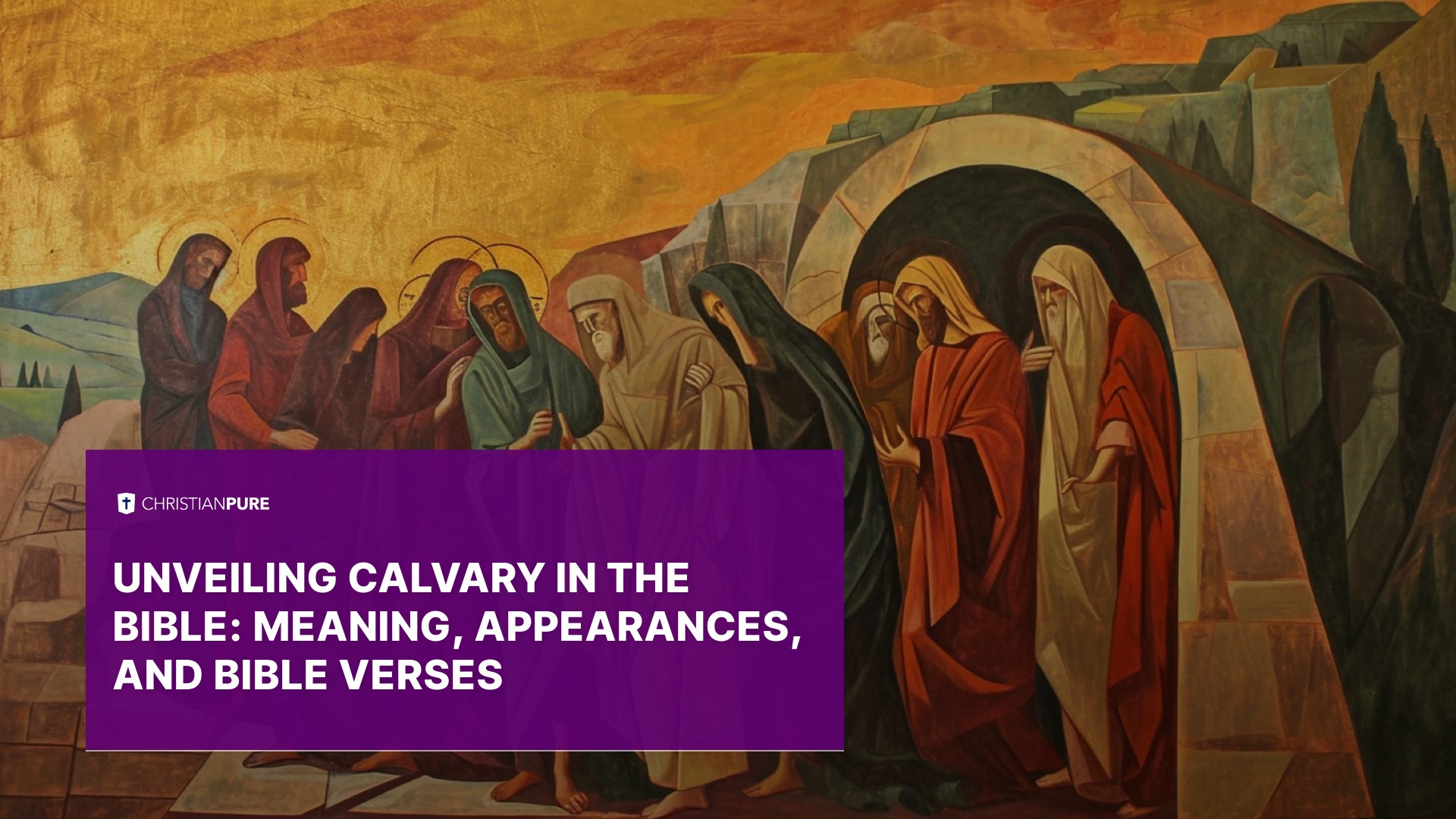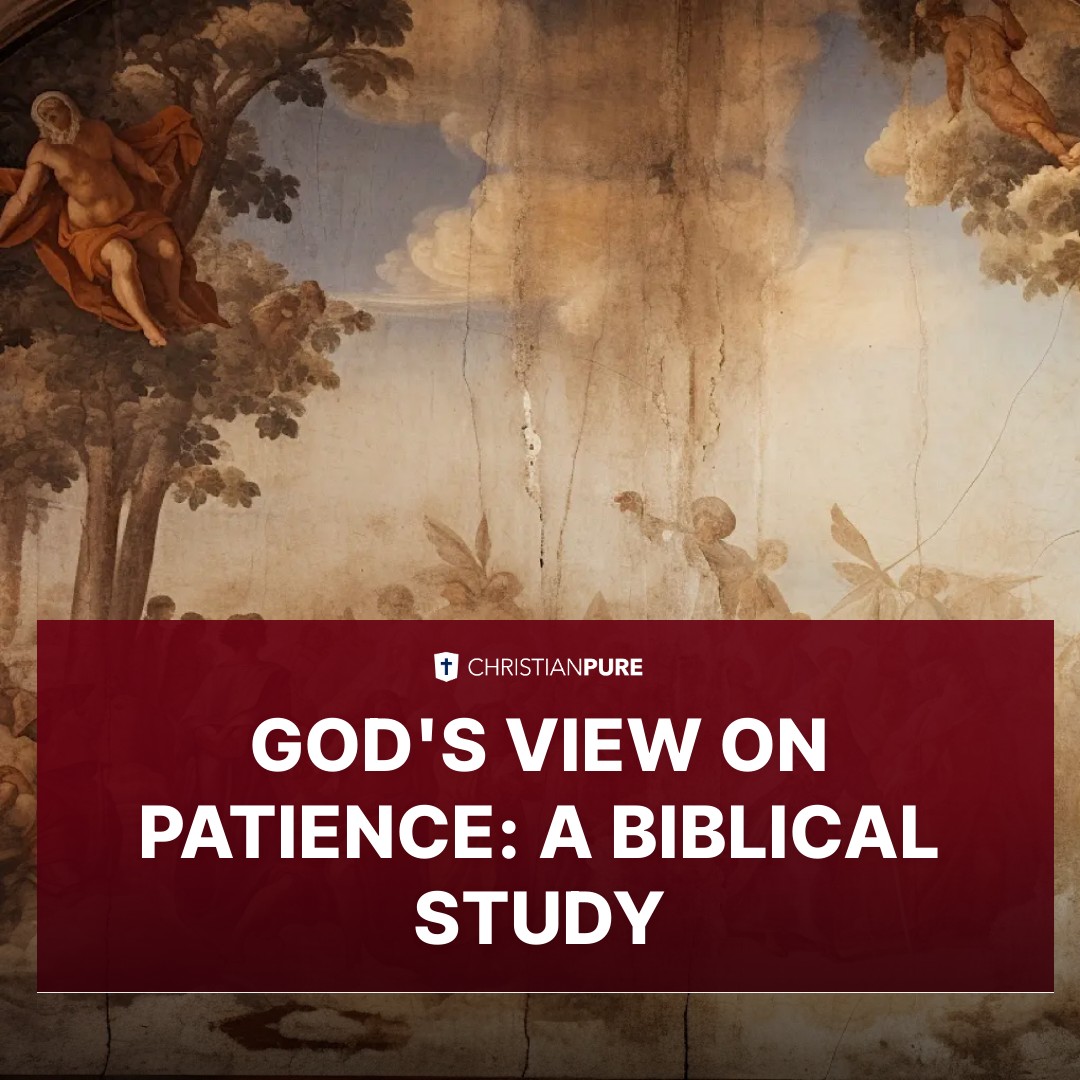At the heart of the Christian faith lies a historic event, embodied in a single place: Calvary. As much as it is a physical location, it is a powerful symbol bearing profound theological significance. Calvary's significance is etched in the annals of biblical exegesis, unfolding layers of contemplation, reverence, and spiritual exploration. Amid the biblical landscape, it serves as the backdrop for the Crucifixion – the pivotal event that marks the culmination of Jesus Christ's earthly life.
"So they took Jesus, and he went out, bearing his cross, to the place called The Place of a Skull, which in Aramaic is called Golgotha" - John 19:17
Known as Golgotha in Aramaic, the Place of the Skull, Calvary emanates with echoes of sacrifice, redemption, and transformative love. It is a space where the human and divine intersect, spawning an enduring narrative of faith and hope.
In this essay, we embark on a journey to explore Calvary in a biblical scope. We will dive into its depiction in Scripture, the frequency of its mention, sketch the contours of its symbolism, and uncover its rich layers of meaning. Come join us as we unravel Calvary, a place as compelling in its absolute silence as it is in its substantial spiritual resonance.
Definition of Calvary in the Bible
In the sacred scriptures, "Calvary" emanates from the Latin word 'Calvaria', which translates to skull or cranium in English. The exact location, known as Mount Calvary, has been etched into religious history as the site of Jesus Christ's crucifixion, marking it as a place of profound spiritual significance. In essence, Calvary is synonymous with Golgotha, the Aramaic term also symbolizing 'the place of the skull', a designation solidified in the hallowed verses of the 1769 King James Version of the Bible.
Many will also recognize Calvary as a frequent feature in English hymns and literature, further underlining its deep-rooted cultural and religious relevance throughout centuries. In fact, it is such a prominent evocation that faith-based communities dedicated to teaching and worship, such as the Calvary Chapel, have adopted the name, emphasizing the profound essence of Calvary in our collective religious consciousness.
Yet we must perceive Calvary as more than a mere geographic location or linguistic interpretation. Its spiritual implications transcend earthly boundaries, permeating the collective consciousness of believers with a symbolic reminder of Christ's immense sacrifice, unconditional love, and the promise of redemption. Just as the image of Mount Calvary evokes a visual reminder of Christ's redemptive act, the mention of Calvary in the Bible invites a spiritual reflection on these profound themes.
Summary:
- Calvary originated from the Latin word Calvaria, which means skull or cranium.
- Mount Calvary is recognized as the place of Jesus Christ's crucifixion.
- Golgotha and Calvary are considered synonymous, both representing 'the place of the skull'.
- Beyond its historical significance, Calvary symbolizes Christ's sacrifice, love, and the promise of redemption to humanity.
What is the significance of Calvary in the Bible?
Calvary, also known as Golgotha, holds a pivotal place in the Christian faith. In Latin, Calvary translates to 'Calvaria', which means 'a skull'. This is equivalent to the term 'Golgotha' in Aramaic, which also signifies 'the place of a skull'. This somber moniker originates from the appearance of the site, said to resemble a skull's features.
This location is of monumental importance to Christianity as it is traditionally recognized as the place where Jesus Christ was crucified. This act of sacrifice is central to Christian teachings and beliefs, representing Jesus' selfless act of love and redemption for humanity's sins. This event, known as the Crucifixion, is perceived as the climactic point in Jesus' earthly ministry. Consequently, Calvary becomes a physical and symbolic embodiment of Jesus' redemptive passion and ultimate sacrifice.
In numerous English literature and hymns, reference is often made to 'Mount Calvary'. This terminology evokes an image of a torturous climb, a symbol of Jesus' arduous journey carrying the cross, further adding to the poignancy of this site.
In the 1769 King James Version of the Bible, Golgotha is mentioned and defined as 'the place of a skull'. Interestingly, Calvary is not explicitly mentioned in this well-regarded version, yet its inherent equivalent, Golgotha, provides us with the unambiguous connection.
Summary:
- Calvary, also known as Golgotha, translates to 'a skull' in Latin and Aramaic respectively.
- It is symbolic and important as the site of Jesus Christ's crucifixion, representing his passion and ultimate sacrifice.
- Calvary alludes to 'Mount Calvary' in English literature and hymns, symbolizing Jesus' laborious journey carrying the cross.
- In the 1769 King James Version, Golgotha is mentioned as 'the place of a skull', linking it unequivocally to Calvary.
How many times is Calvary mentioned in the Bible?
The term 'Calvary' appears in the 1769 King James Version of the Bible only once, in Luke 23:33: "And when they were come to the place, which is called Calvary, there they crucified him, and the malefactors, one on the right hand, and the other on the left." This solitary reference signifies the magnitude of the scene it depicts. Despite its single mention, Calvary has gained enormous importance due to the event it represents - the crucifixion of Jesus Christ.
Several variations of the Bible, however, refer to Calvary in different terms. Notably, 'Golgotha', a term used interchangeably with 'Calvary', appears more frequently. It is referenced multiple times in the biblical texts of Matthew 27:33, Mark 15:22, and John 19:17. The term 'Calvary' itself is rooted in Latin - 'Calvariae', which translates to 'the place of the skull'. This refers not only to the physical description of the hill where Christ was crucified but also symbolically to the death, sacrifice, and eventual resurrection of Jesus.
'Calvary', therefore, though only mentioned once, remains deeply etched into the collective consciousness of Christian believers around the world. It acts as a quintessential symbol of the Passion of Christ, encompassing themes of sacrificial love, ultimate redemption, and transformative resurrection.
Summary:
- Calvary is mentioned only once in the 1769 King James Version of the Bible, in Luke 23:33.
- The term 'Golgotha' appears more frequently in biblical texts, and is used interchangeably with 'Calvary'.
- 'Calvary' derives from the Latin 'Calvariae', meaning 'the place of the skull'.
- Despite its single mention, Calvary's significance lies in the event it represents - the crucifixion of Jesus Christ.
Does the Old Testament mention Calvary?
In a technical sense, the Old Testament does not mention Calvary per se, as the term itself is closely linked to the New Testament narratives surrounding the crucifixion of Jesus Christ. However, this in no way implies a void of significance in the Old Testament with relation to the concept embodied by Calvary. In fact, many Christian theologians and students of the Bible see within the tapestry of Old Testament history and prophesy, reflections, and anticipations of the events at Calvary.
Take, for instance, the poignant account of Abraham’s sacrifice of Isaac in Genesis 22. A beloved son, a mountainous location, possibly in the region of Moriah where Jesus was crucified, a willing surrender to the will of God - these elements serve as powerful precursors to Calvary's story. The prophet Isaiah, too, in chapters 52 and 53 of his book, foretells of the suffering servant who 'was wounded for our transgressions, bruised for our iniquities' - words that resonate powerfully with the later New Testament descriptions of Christ’s death on Calvary.
While these passages may not refer to Calvary by name, they contribute to the theological scaffolding that surrounds Calvary, enriching our understanding of the place of the skull. They set a stage, long in advance, for that momentous event, echoing its themes of sacrifice, obedience, redemption, and forgiveness. Thus, while the name Calvary may be absent from the Old Testament, its spiritual and theological implications are deeply woven into its fabric.
Summary:
- The term Calvary, specifically related to Jesus Christ's crucifixion, does not technically appear in the Old Testament.
- Instances in the Old Testament such as Abraham’s sacrifice of Isaac and the prophesies of Isaiah echo the themes of Calvary.
- The Old Testament contributes to Calvary's theological understanding, even without explicitly mentioning the term.
Is Calvary only associated with the crucifixion of Jesus?
In the collective memory of the Christian faith, the archetype of Calvary is intrinsically bound to Jesus Christ's crucifixion. While the word "Calvary" is often employed as a metonym for the Crucifixion itself, the biblical and theological reality is more nuanced.
Indeed, it is crucial to note that Calvary, known as Golgotha in Aramaic, which translates to "the Place of the Skull," is used exclusively in the New Testament, and specifically in the Gospels, to denote the location of Christ's crucifixion (Matthew 27:33, Mark 15:22, John 19:17). These sacred texts do not speak of Calvary separately from the event of the Crucifixion. As such, from a strictly biblical perspective, Calvary is, in fact, solely associated with the crucifixion of Jesus. Scholarly investigations of ancient literature and archaeological findings resonate with this depiction.
Nonetheless, theological interpretations of Calvary have transcended this literal association, investing it with profound symbolic significance. Some Christian traditions, particularly those with a keen sense of sacramental and mystical theology, recognize Calvary as a spiritual locus where heaven and earth met in a dramatic encounter. Others consider Calvary a monument of epic redemptive act—a crucible of love, sacrifice, and divine triumph over death.
Given these perspectives, while it is accurate to say that the term 'Calvary' is directly associated with the crucifixion of Jesus, its resonances within Christian theology are manifold and wide-reaching.
Summary:
- Calvary, or Golgotha, is mentioned in the New Testament, particularly in the Gospels, exclusively as the site of Jesus Christ's crucifixion.
- In a strictly biblical context, Calvary is unequivocally linked to the Crucifixion.
- Theological interpretations of Calvary, however, expand its significance beyond the literal, associating it with themes such as divine love, sacrifice, and victory over death.
- Though directly tied to the Crucifixion, the implications of 'Calvary' within Christian theology and spirituality are multifaceted and profound.
What is the symbolism of Calvary in the Bible?
Before we delve into the profound symbolism of Calvary in the Bible, it's important to first provide a brief overview. Calvary, known as Golgotha in Aramaic, signifies 'the place of the skull.' Its Latin equivalent is 'Calvaria,' which consequently stands as the English word 'Calvary.' No matter what moniker is employed, all point to the biblical location where Jesus Christ was crucified, serving as a critical plot point in the narrative of human redemption.
At the forefront, Calvary's symbolism is epitomized by the Cross on which Jesus was crucified. This Cross, scarlet with the blood of Christ Jesus, stands as an emblem of atonement, sacrifice, and pardon. In this act, love, righteousness, and justice beautifully converged as God's saving grace extended to all of humanity. Because of Calvary, the Cross ceased to be an instrument of death and emerged as a testament of life and everlasting hope.
But the implications of Calvary's symbolism dig deeper. The skull-like shape it's named after hints at death and humanity's tremendous need for deliverance from sin. Yet, it's where death finds its ultimate defeat, as Christ's triumphant resurrection from the grave three days post-crucifixion turned Calvary into a beacon of victory over sin and mortality.
Interestingly, the possible origins of the name 'Calvary,' whether from a place scattered with skulls, a nearby cemetery, or the physical contour of the location, all concur to its overall symbolism – that from death sprouts life, from defeat rises victory, and from sin emerges salvation.
Summary:
- Calvary, also known as Golgotha, is the biblical place where Jesus Christ was crucified.
- The word 'Calvary' signifies 'the place of the skull' in Latin, hinting at death and humanity's need for deliverance from sin.
- The Cross of Calvary symbolizes atonement, sacrifice, and redemption, marking a significant point in the narrative of human salvation.
- Despite its association with death, Calvary symbolizes victory over sin and mortality through Christ's Resurrection.
- The different origins of the name 'Calvary' strengthen its overall symbolism: from death emerges life, from defeat arises victory, and from sin springs salvation.
How is Calvary depicted in different versions of the Bible?
In the sacred pages of the Bible, Calvary, also known as Golgotha, is depicted in different manners, reflective of the varied translations and versions that have evolved over time. Each portrayal, imbued with a spirit of solemnity and reverence, grants us a unique insight into the Crucifixion narrations and the symbolism underlying them.
In reference to the 1769 King James Version, Calvary receives mention as Golgotha, interpreted as 'the place of a skull'. This symbolism draws upon the macabre image of death, in stark contrast with the life and resurrection that came to define Jesus Christ.
The English language has embraced 'Calvary' from the Latin form, 'Calvaria', indicating 'a skull'. This terminology came about as a result of translations by Jerome in the Vulgate Latin, setting out 'Calvariae' and 'Golgotha' for the readers.
The term 'Mount Calvary' has also established a notable presence in English hymns and literature, fortified by the image of a place of sacrifice, atonement, and redemption. The journey to this Mount and descent via steps has often been employed as potent metaphors for spiritual journeys and the pathway towards salvation.
In the multitude of these versions and translations, the thread of continuity that persists embodies Calvary as the locus of Jesus Christ's ultimate sacrifice, an event of monumental significance echoing across time and generations. Each version enhances our understanding of the Crucifixion and the overwhelming narrative of salvation embedded in it.
Summary:
- Transliterations of 'Calvary' differ across Bible versions, reflective of its Latin origin 'Calvaria', and 'Golgotha' from the 1769 King James Version.
- 'Calvary' bears significant presence in English hymns and literature, often symbolizing a spiritual journey or pathway towards atonement and redemption.
- Despite translational variations, the common thread linking all depictions is Calvary as the site of Jesus Christ's Crucifixion - the epitome of sacrifice, echoing over generations.
Does the meaning of Calvary change across different Christian denominations?
Within Catholicism, the word 'Calvary' is steeped in the most profound reverence. The scene of Christ's ultimate sacrifice, Calvary serves as the center-stage for the sacrament of the Eucharist, ritually reenacting Christ's Passion, Death, Resurrection, and Ascension. A walk up to the altar, for a Catholic, symbolizes the spiritual journey up to Calvary, a path trodden in the footsteps of Christ. Protestant denominations, on the other hand, often view Calvary as a powerful symbol of Salvation.
The focus remains less on ritualistic reenactment, and more on the personal acceptance of Jesus Christ as a savior, a throne that was claimed at Calvary when Christ triumphed over death.
For Orthodox Christianity, Calvary represents the culmination of Christ's extreme humility. As the place where Christ, being God, suffered the ultimate human experience - death - it symbolizes the paradox of God becoming man to elevate humanity and is a constant reminder of His self-emptying love.
It is vital to remember, however, regardless of the myriad interpretations of Calvary, all Christian denominations share the foundational belief in the significance of Christ's sacrifice at Calvary as the cornerstone of salvation and the defining moment of Christianity.
Summary:
- Within Catholic traditions, Calvary is central to the sacrament of the Eucharist and represents a spiritual journey in Christ's footsteps.
- Many Protestant denominations view Calvary as a symbol of personal salvation, focusing on accepting Jesus Christ as a savior at Calvary.
- For Orthodox Christianity, Calvary signifies Christ's humility and His paradoxical journey from God to man, symbolizing His self-emptying love.
- Despite varying interpretations, all Christian denominations believe in the significance of Christ Jesus's sacrifice at Calvary as the cornerstone of Salvation and Christianity.
Are there any controversies or debates related to the biblical interpretation of Calvary?
With regard to the interpretation of Calvary, we enter an arena of discussion that straddles both history and theology. The precision of Calvary's location has indeed fueled extensive debates amongst esteemed scholars and historians. Some are swayed by the weight of archaeological evidence and ancient literature, which supports the notion of Christ's crucifixion at Calvary. However, panoramic considerations of the exact progression of Jerusalem's walls during the time of Jesus' crucifixion raise considerable questions for the more skeptical minds.
Furthermore, uncertainty proliferates around the interpretative portrayal of Calvary in the biblical text itself. For instance, the 1769 King James version distinctly describes Golgotha, Calvary’s Aramaic equivalent, as the 'place of a skull'. However, the conspicuous absence of specific skull-related indications in the descriptions given by the Evangelists has fostered interpretative disagreements. Some theological circles argue that the concept of 'skull' is merely a metaphor, while others maintain a more literal interpretation, viewing Calvary as a location strewn with skulls due to being a site of public execution.
Equally significant is the dialogue concerning the origin of the name 'Calvary'. Interpretations vary, with some persuasions suggesting it’s derived from a nearby cemetery due to the etymological links with the Latin word 'calvaria', meaning skull, pointing to the physical contour of the place. Other theories postulate that its naming derives from it being a place of public executions, implying a potentially chilling landscape of ‘scattered skulls’.
Thus, the concept of 'Calvary' in the Bible is more than a geographical landmark; it is a hive of biblical, historical, and theological discourse. Differences in interpretative leanings and the scarcity of concrete supporting evidence have entrenched the place of Calvary as a sustained area of intrigue and debate in biblical studies.
Summary:
- Intriguing debates exist regarding the precise location of Calvary, with some scholars pointing to archaeological evidence and ancient literature that suggest its location, while others debate the historical progression of the Jerusalem city wall.
- Interpretations of biblical descriptions of Calvary vary. The principal point of contention lies in the depiction of Golgotha as the 'place of a skull' in the 1769 King James version, a detail noticeably absent in the Evangelists' accounts.
- There are various theories on the origin of the term 'Calvary', ranging from its derivation from nearby cemetery or its association with the nature of its use as a place of public execution.
- The concept of 'Calvary' is not just a geographical reference but also a site of engaging biblical, historical, and theological dialogue.
Are there any prophecies in the Bible related to Calvary?
Despite the term 'Calvary' not being directly referred to in Old Testament prophecies, it bears significance as the place where prophecies about the Messiah fulfilled. Isaiah 53:5 foretold,"But he was wounded for our transgressions, he was bruised for our iniquities: the chastisement of our peace was upon him; and with his stripes we are healed." Scholars have long interpreted this prophecy as presaging Jesus's great sacrifice on the cross at Calvary.
Additionally, in Psalm 22, we find a disturbingly accurate picture of a man suffering in a manner that mirrors Christ’s crucifixion, hundreds of years before crucifixion was even invented. This prefigures the Saviour's affliction at Calvary. Verses 16 to 18 say, "Dogs surround me, a pack of villains encircles me; they pierce my hands and my feet. All my bones are on display; people stare and gloat over me. They divide my clothes among them and cast lots for my garment."
Finally, Daniel 9:26 prophesied: "And after sixty-two weeks, an anointed one shall be cut off and shall have nothing." This prophecy is believed to point directly to the coming Messiah’s death. While all these prophecies do not mention 'Calvary,' they laid the biblical foundation for the event that took place there.
Summary:
- Although the term 'Calvary' does not appear directly in Old Testament prophecies, the place holds significance as the fulfillment site of several Messiah-related prophecies.
- The prophecy of Isaiah 53:5 paints a portrait of the Saviour suffering for our 'transgressions' and 'iniquities', an image fulfilled at Calvary.
- Psalm 22 presents a disturbingly precise description of Jesus' crucifixion at Calvary.
- Although Daniel 9:26 doesn't mention Calvary by name, the prophecy seems to foreshadow the event that would take place there, suggesting the Messiah would be "cut off".
Facts & Stats
The term 'Calvary' is derived from the Latin word 'calvaria', which means 'skull'
Calvary is also referred to as 'Golgotha', an Aramaic term meaning 'the place of the skull'
Calvary is mentioned in all four Gospels of the New Testament: Matthew, Mark, Luke, and John
The event at Calvary is the basis for many Christian doctrines, including salvation and atonement
References
Luke 23:33
Luke 23:43
Mark 15:22
John 3:16-18
John 19:20
John 19:30
John 1:29
Matthew 27:33
Matthew 27:50
Matthew 27:53
Mark 15:37-38




















